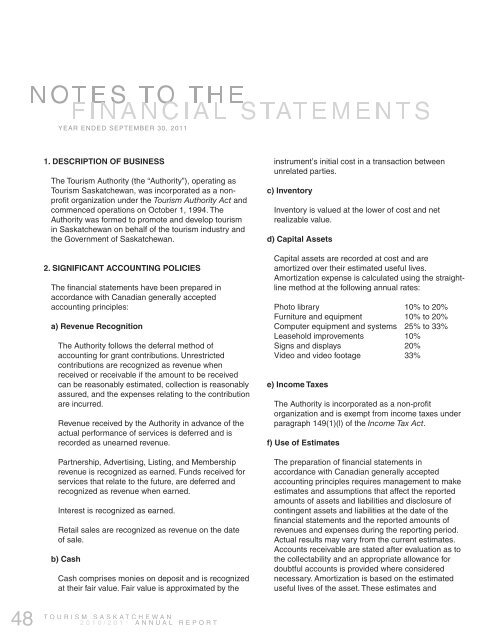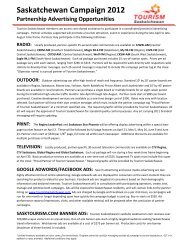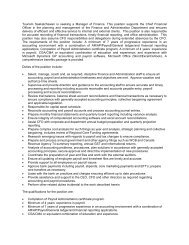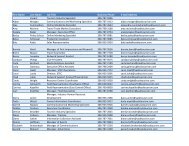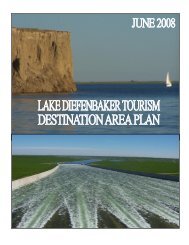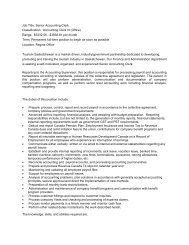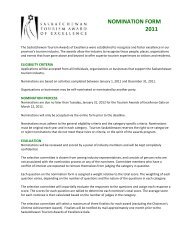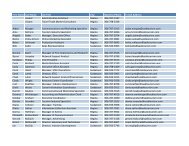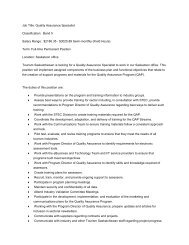Tourism Saskatchewan - IndustryMatters.com
Tourism Saskatchewan - IndustryMatters.com
Tourism Saskatchewan - IndustryMatters.com
Create successful ePaper yourself
Turn your PDF publications into a flip-book with our unique Google optimized e-Paper software.
YEAR ENDED SEPTEMBER 30, 2011<br />
1. DESCRIPTION OF BUSINESS<br />
The <strong>Tourism</strong> Authority (the “Authority”), operating as<br />
<strong>Tourism</strong> <strong>Saskatchewan</strong>, was incorporated as a nonprofit<br />
organization under the <strong>Tourism</strong> Authority Act and<br />
<strong>com</strong>menced operations on October 1, 1994. The<br />
Authority was formed to promote and develop tourism<br />
in <strong>Saskatchewan</strong> on behalf of the tourism industry and<br />
the Government of <strong>Saskatchewan</strong>.<br />
2. SIGNIFICANT ACCOUNTING POLICIES<br />
The financial statements have been prepared in<br />
accordance with Canadian generally accepted<br />
accounting principles:<br />
a) Revenue Recognition<br />
The Authority follows the deferral method of<br />
accounting for grant contributions. Unrestricted<br />
contributions are recognized as revenue when<br />
received or receivable if the amount to be received<br />
can be reasonably estimated, collection is reasonably<br />
assured, and the expenses relating to the contribution<br />
are incurred.<br />
Revenue received by the Authority in advance of the<br />
actual performance of services is deferred and is<br />
recorded as unearned revenue.<br />
Partnership, Advertising, Listing, and Membership<br />
revenue is recognized as earned. Funds received for<br />
services that relate to the future, are deferred and<br />
recognized as revenue when earned.<br />
Interest is recognized as earned.<br />
Retail sales are recognized as revenue on the date<br />
of sale.<br />
b) Cash<br />
Cash <strong>com</strong>prises monies on deposit and is recognized<br />
at their fair value. Fair value is approximated by the<br />
instrument’s initial cost in a transaction between<br />
unrelated parties.<br />
c) Inventory<br />
Inventory is valued at the lower of cost and net<br />
realizable value.<br />
d) Capital Assets<br />
Capital assets are recorded at cost and are<br />
amortized over their estimated useful lives.<br />
Amortization expense is calculated using the straightline<br />
method at the following annual rates:<br />
Photo library 10% to 20%<br />
Furniture and equipment 10% to 20%<br />
Computer equipment and systems 25% to 33%<br />
Leasehold improvements 10%<br />
Signs and displays 20%<br />
Video and video footage 33%<br />
e) In<strong>com</strong>e Taxes<br />
The Authority is incorporated as a non-profit<br />
organization and is exempt from in<strong>com</strong>e taxes under<br />
paragraph 149(1)(l) of the In<strong>com</strong>e Tax Act.<br />
f) Use of Estimates<br />
The preparation of financial statements in<br />
accordance with Canadian generally accepted<br />
accounting principles requires management to make<br />
estimates and assumptions that affect the reported<br />
amounts of assets and liabilities and disclosure of<br />
contingent assets and liabilities at the date of the<br />
financial statements and the reported amounts of<br />
revenues and expenses during the reporting period.<br />
Actual results may vary from the current estimates.<br />
Accounts receivable are stated after evaluation as to<br />
the collectability and an appropriate allowance for<br />
doubtful accounts is provided where considered<br />
necessary. Amortization is based on the estimated<br />
useful lives of the asset. These estimates and<br />
48


